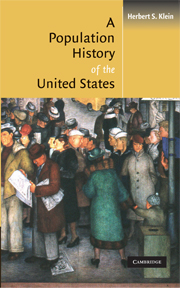Book contents
- Frontmatter
- Contents
- Graphs, Maps, and Tables
- Introduction
- 1 Paleo–Indians, Europeans, and the Settlement of America
- 2 Colonization and Settlement of North America
- 3 The Early Republic to 1860
- 4 The Creation of an Industrial and Urban Society, 1860–1914
- 5 The Evolution of a Modern Population, 1914–1945
- 6 The Baby Boom and Changing Family Values, 1945–1980
- 7 A Modern Industrial Society, 1980–2003
- Appendix: Tables, Graphs, and Maps
- Bibliography
- Index
4 - The Creation of an Industrial and Urban Society, 1860–1914
Published online by Cambridge University Press: 05 June 2012
- Frontmatter
- Contents
- Graphs, Maps, and Tables
- Introduction
- 1 Paleo–Indians, Europeans, and the Settlement of America
- 2 Colonization and Settlement of North America
- 3 The Early Republic to 1860
- 4 The Creation of an Industrial and Urban Society, 1860–1914
- 5 The Evolution of a Modern Population, 1914–1945
- 6 The Baby Boom and Changing Family Values, 1945–1980
- 7 A Modern Industrial Society, 1980–2003
- Appendix: Tables, Graphs, and Maps
- Bibliography
- Index
Summary
The period from 1860 to 1914 was marked by a series of short-term fluctuations and long-term demographic changes in the national population. The Civil War proved to be the most costly in human life of any war suffered by the United States up to this time. This resulted in short-term changes in mortality and fertility. In fact, mortality remained high during most of this period, replicating the patterns of high and fluctuating rates that were the norm for the earlier 19th-century period. But all this would change profoundly after 1870, when death rates in the United States would finally begin a steady and long-term decline. Without question this was to prove to be the most important demographic event in this and the following period. Other trends intensified in this second half of the 19th century and, in turn, were influenced by new evolving forces within national society. Clearly, fertility, which had been on a long-term decline, accelerated that decline at the end of this period and seemed to be more influenced by urban and modern economic factors than had traditionally been the case. Also, the mechanism of controlling natality seem to be changing in important ways in this period, with marital fertility itself declining. These rates also finally reached the low western European levels by the last decade of the century. Abolition of slavery led to profound changes in African American literacy, labor participation, and conditions of health and welfare.
- Type
- Chapter
- Information
- A Population History of the United States , pp. 107 - 144Publisher: Cambridge University PressPrint publication year: 2004

